Kevin Hazzard - Metaprogramming in .NET
Here you can read online Kevin Hazzard - Metaprogramming in .NET full text of the book (entire story) in english for free. Download pdf and epub, get meaning, cover and reviews about this ebook. year: 2013, publisher: Manning Publications, genre: Computer. Description of the work, (preface) as well as reviews are available. Best literature library LitArk.com created for fans of good reading and offers a wide selection of genres:
Romance novel
Science fiction
Adventure
Detective
Science
History
Home and family
Prose
Art
Politics
Computer
Non-fiction
Religion
Business
Children
Humor
Choose a favorite category and find really read worthwhile books. Enjoy immersion in the world of imagination, feel the emotions of the characters or learn something new for yourself, make an fascinating discovery.
- Book:Metaprogramming in .NET
- Author:
- Publisher:Manning Publications
- Genre:
- Year:2013
- Rating:4 / 5
- Favourites:Add to favourites
- Your mark:
Metaprogramming in .NET: summary, description and annotation
We offer to read an annotation, description, summary or preface (depends on what the author of the book "Metaprogramming in .NET" wrote himself). If you haven't found the necessary information about the book — write in the comments, we will try to find it.
Summary
Metaprogramming in .NET is designed to help readers understand the basic concepts, advantages, and potential pitfalls of metaprogramming. It introduces core concepts in clear, easy-to-follow language and then it takes you on a deep dive into the tools and techniques youll use to implement them in your .NET code. Youll explore plenty of real-world examples that reinforce key concepts. When you finish, youll be able to build high-performance, metaprogramming-enabled software with confidence.
About the Technology
When you write programs that create or modify other programs, you are metaprogramming. In .NET, you can use reflection as well as newer concepts like code generation and scriptable software. The emerging Roslyn project exposes the .NET compiler as an interactive API, allowing compile-time code analysis and just-in-time refactoring.
About this Book
Metaprogramming in .NET is a practical introduction to the use of metaprogramming to improve the performance and maintainability of your code. This book avoids abstract theory and instead teaches you solid practices youll find useful immediately. It introduces core concepts like code generation and application composition in clear, easy-to-follow language.
Written for readers comfortable with C# and the .NET frameworkno prior experience with metaprogramming is required.
Purchase of the print book comes with an offer of a free PDF, ePub, and Kindle eBook from Manning. Also available is all code from the book.
Whats Inside
- Metaprogramming concepts in plain language
- Creating scriptable software
- Code generation techniques
- The Dynamic Language Runtime
About the Authors
Kevin Hazzard is a Microsoft MVP, consultant, teacher, and developer community leader in the mid-Atlantic USA. Jason Bock is an author, Microsoft MVP, and the leader of the Twin Cities Code Camp.
An excellent way to start fully using the power of metaprogramming.From the Foreword by Rockford Lhotka, Creator of the CSLA .NET Framework
Table of Contents
- PART 1 DEMYSTIFYING METAPROGRAMMING
- Metaprogramming concepts
- Exploring code and metadata with reflection PART 2 TECHNIQUES FOR GENERATING CODE
- The Text Template Transformation Toolkit (T4)
- Generating code with the CodeDOM
- Generating code with Reflection.Emit
- Generating code with expressions
- Generating code with IL rewriting PART 3 LANGUAGES AND TOOLS
- The Dynamic Language Runtime
- Languages and tools
- Managing the .NET Compiler
Kevin Hazzard: author's other books
Who wrote Metaprogramming in .NET? Find out the surname, the name of the author of the book and a list of all author's works by series.

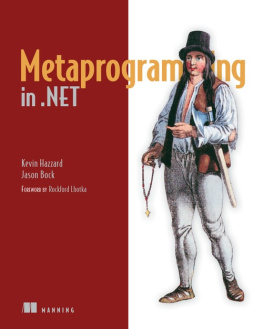




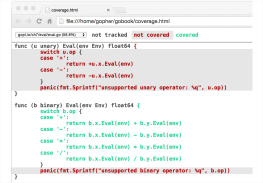
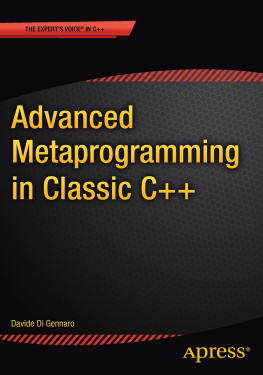



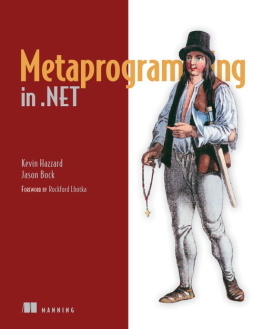
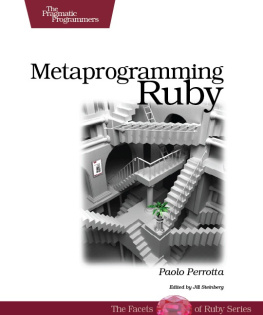


 Recognizing the importance of preserving what has been written, it is Mannings policy to have the books we publish printed on acid-free paper, and we exert our best efforts to that end. Recognizing also our responsibility to conserve the resources of our planet, Manning books are printed on paper that is at least 15 percent recycled and processed without the use of elemental chlorine.
Recognizing the importance of preserving what has been written, it is Mannings policy to have the books we publish printed on acid-free paper, and we exert our best efforts to that end. Recognizing also our responsibility to conserve the resources of our planet, Manning books are printed on paper that is at least 15 percent recycled and processed without the use of elemental chlorine.